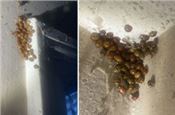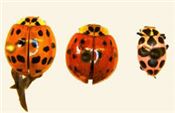Overwintering Asian Lady Beetles Might Extend Their Fly Period In 2021
DR. RAUL T. VILLANUEVA
PRINCETON, KENTUCKY
I observed several clusters of more than 50 multicolored Asian lady beetles (Harmonia axyridis) per cluster in my garage (Figure 1). I left the garage door open for an entire day during the second week of November, and the beetles moved in. These lady beetles were looking for a sheltered space to overwinter. This behavior usually occurs from September to October in Kentucky, but the warmer days in early November (temperatures above 70° F) might have caused the late flight event.
The multicolored Asian lady beetle is an exotic predacious insect that is beneficial when it is outdoors but becomes unpleasant when it moves into man-made structures and remains indoors during the winter.
Although this is an arboreal species in western Kentucky, it is widely observed in soybean, corn, and wheat fields.
Status & Morphological Description
Multicolored Asian lady beetles have been released in the USA many times since 1916, and the latest, more intensive releases were conducted in the 1980s. However, the first detections of established populations in the USA were in Louisiana in 1988. There is too much debate about the unsuccessful detection before 1988, despite the numerous releases in North America. It is possible that the many color variations of this ladybug misguided early observers. Multicolored Asian lady beetle occurs in many color morphs: ranging from pale orange to bright orange, with or without black spots on the wing covers, or completely black wings with bright orange spots. Adults are oval and convex, approximately 6 mm long, and 5 mm wide. A distinctive key characteristic in most morphs is an M-shaped mark on the pronotum (Figure 2).
Problems with the Increasing Populations of Asian Multicolored Lady Beetle.
This species has been released and detected in Europe, North America, South America, and Africa. In agricultural systems, it has beneficial effects by reducing populations of many pests in distinct crops.
Nevertheless, there are many reports that shown negative effects of this introduced species. These are described below:
Preying on non-target organisms: Due to the absence of natural enemies controlling this exotic species, Asian multicolored lady beetle populations are increasing, outcompeting native ladybug species, and displacing them in some ecological systems. They are generally larger than native species (Figure 2) and they prey on eggs or immature stages of native lady beetle species. Some studies have shown that Asian multicolored lady beetle can complete its life cycle feeding on larvae and eggs of native lady beetles.
Damage to high value crops: In the fall, Asian multicolored lady beetles aggregate on ripening fruit; apples, grapes, and raspberries are the main targets. They have been observed feeding on fruit damaged by birds or other organisms. In apples, the presence may not be important; however, in highly valued fruit, this damage maybe important. In grapes, there is information that shows that their presence on grape clusters that are crushed for wine taint the flavor of the resulting wine when the alkaloids contained in this insect are released. In addition, Asian multicolored lady beetle will occasionally bite humans during grape harvesting.
Overwintering in structures: This species is an invader of human-built constructions when they swarm into homes in late fall. Inside homes, the beetles walk on ceilings and fly around light fixtures. When disturbed, they emit a foul odor and excrete a fluid that stains walls, carpets, curtains, and furniture.
Food contaminant: Asian multicolored lady beetles can be a contaminant of the food industry and cause allergies.
Management of the Asian Lady Beetle in Structures The publication Asian Lady Beetle Infestation of Structures (ENTFACT-416) provides extensive information on how to manage this insect in buildings. I will briefly enumerate the methods to manage these infestations taken from the cited publication:
Vacuuming: Probably the easiest way to remove them, this method allows you to release the beetles outdoors.
Sealing cracks and openings is the most permanent way of preventing lady beetles from entering buildings.
Insecticides: Insecticide foggers or sprays are generally not recommended for eliminating beetles indoors. Insecticides applied indoors for lady beetles tend to be ineffective and may stain or leave unwanted residues on walls. Fast-acting residual insecticides can be sprayed outdoors in targeted bands around windows, doors, eaves, soffits, attic vents, and other likely points of entry. This practice using the more effective insecticides needs to be conducted by professionals. To be effective, barrier treatments should be applied before the beetles enter buildings to overwinter. In Kentucky, the proper timing for such treatments is typically late-September to early October. This year, the infestation in western Kentucky may have occurred in early November–I observed lady beetles flying while scouting for aphids in wheat fields at that time. ∆
DR. RAUL T. VILLANUEVA: Entomology Extension Specialist, University of Kentucky

Figure 1. Clusters of multicolored Asian lady beetles on window frame and ceiling.
Photos: Raul Villanueva, UK

Figure 2. Two multicolored Asian lady beetles (left) showing two color morphs, different spots, and the distinctive
M-shape spot in pronotum. The native spotted pink lady beetle is at the far right.